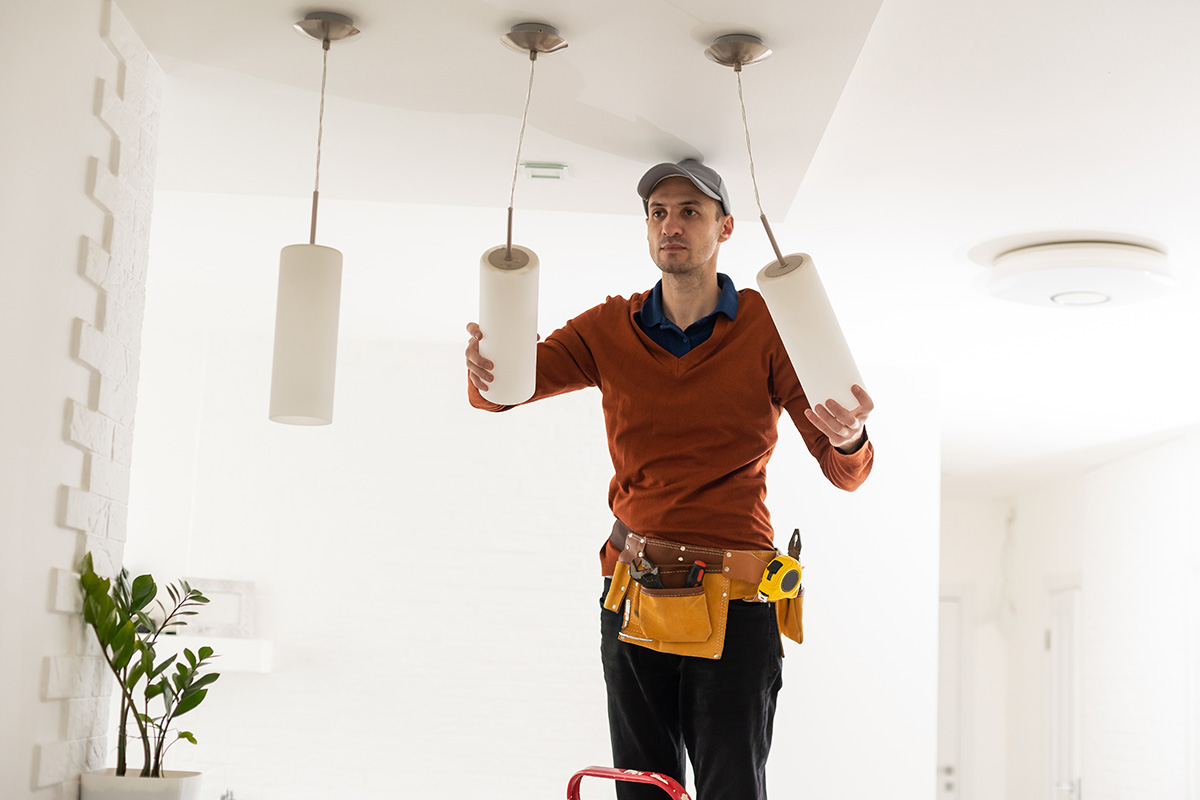Real Estate
Transform your home with energy-efficient LED lighting
Add sconces, lamps, outdoor accents, and more

The light-emitting diode (LED) is today’s most energy-efficient and rapidly developing lighting technology. Quality LED light bulbs not only last longer but are more durable and provide comparable or better light quality than other types of lighting. In fact, the inventors of the LED were awarded the Nobel Prize in Physics in 2014 for their groundbreaking invention. This simple bulb has transformed how we light our homes, significantly reducing energy usage and reshaping the future of home lighting.
When incorporated effectively, LED lights into your home can create a visually appealing as well as an energy-efficient environment. Let’s both save on electricity bills and also do this aesthetically well.
As the real estate market in Washington, D.C., continues to evolve, landlords are constantly looking for ways to make their properties more appealing to tenants. One of the simplest yet most impactful upgrades a property owner can make is improving the lighting in their rental units, particularly by using LED lighting. LED technology offers a range of benefits that can transform spaces, improve energy efficiency, and enhance tenant satisfaction.
Incorporating Downlighting with LED Technology
LED downlights are a popular choice for those looking to add modern, subtle lighting to their homes. According to a post on Quora by contributor Nick Chris, “LED downlights can be installed in ceilings to provide direct and focused lighting, perfect for task-oriented areas like kitchens or bathrooms.” The post also highlights that downlights can be used in living rooms to create ambient lighting, adding that “LED downlights are a great option for areas where you want to minimize the visibility of the light fixture itself while maximizing the impact of the light.”
By using LED downlights strategically, you can direct light exactly where you need it, providing both functional and aesthetic benefits.
Lighting Dark Spaces: Transforming Basements and Beyond
One of the biggest challenges landlords face is making dark or poorly lit areas more inviting, especially in basements. LED lighting, particularly flat ceiling spots, can dramatically change the ambience of these spaces. Many basements in older homes or rental units can feel dark and uninviting, but by installing LED ceiling fixtures, landlords can make these areas bright, warm, and attractive. Tenants often respond positively to these improvements, as a well-lit basement can shift the overall perception of a property from gloomy to welcoming.
The key benefit of these LED fixtures is that they don’t require much ceiling space, making them easy to install in areas with lower ceilings. This is particularly useful in basements, where ceiling height is often limited. Additionally, these lights can be strategically placed to maximize illumination without overcrowding the room, allowing for better use of the space.
Customizing the Mood
LED lighting provides not only brightness but also versatility. One of the standout features is the ability to adjust both the color temperature and the brightness level. This allows for light customization, from bright, crisp white to a softer, more soothing yellow. For landlords, this flexibility helps in creating comfortable and appealing environments that can suit a wide range of tenant preferences, whether in living rooms, bedrooms, or basements.
Many LED fixtures also come with dimmable options, giving both landlords and tenants more control over the lighting. In practice, this means the lighting can be adapted for different times of the day or for various activities, making it a versatile choice for rental properties.
Energy Efficiency
Another major advantage of LED lighting is its cost-saving potential. LEDs consume only a fraction of the energy required by traditional incandescent or CFL bulbs, leading to significantly lower electricity bills. This is beneficial for landlords in common areas or in rental units where utilities are included in the rent, as well as for tenants who are responsible for their own utility payments.
With LEDs, landlords can also reduce maintenance costs, as these bulbs last much longer than traditional ones and do not need to be replaced as frequently. This durability is a major asset, particularly in rental properties where long-term reliability is essential.
Enhancing Curb Appeal
Lighting improvements aren’t limited to interiors. LED bulbs can also be used effectively in exterior fixtures to enhance curb appeal. Bright, efficient lighting in entryways, pathways, and parking areas not only makes properties more attractive, but also improves safety for tenants returning home after dark.
By installing LED lighting outdoors, landlords can create a welcoming and secure environment for tenants, further increasing the value and desirability of their rental properties. Additionally, the long-lasting nature of LED bulbs means exterior lighting can remain functional for extended periods without the need for frequent replacements.
Tailoring LED Lighting to Each Property
When it comes to lighting solutions, one size does not fit all. LED lighting offers the flexibility to tailor lighting solutions based on the specific needs of each property. Whether upgrading overhead fixtures in living spaces or installing adjustable LED spots in dim basements, landlords can use LED lighting to enhance their properties’ function and appeal. By investing in high-quality fixtures and leveraging the energy efficiency, versatility, and brightness of LEDs, landlords can improve tenant satisfaction and retention, making their properties more competitive in the rental market.
Practical and Decorative Uses for LED Lights
LEDs aren’t just for basic lighting needs; they can be used to enhance the aesthetic appeal of your living spaces. Here are some creative ways to incorporate LED lighting into your home:
Accent Lighting: Under-Cabinet Lighting: LED strips installed under kitchen cabinets not only illuminate your countertops but also add a sleek, modern touch.
Bookshelves and Display Cases: Showcase your favorite books or collectibles by integrating LEDs into your shelves.
Toe-Kick Lighting: Installing LED strips along baseboards or under bathroom and kitchen cabinets adds a subtle and modern glow.
Task Lighting
Desk Lamps: For workspaces, LED desk lamps provide focused, bright light, which can reduce eye strain.
Reading Nooks: Place LED floor or table lamps in cozy corners to create well-lit spaces perfect for reading.
Ambient Lighting
Cove Lighting: Install LED strips in ceiling recesses or coves to create indirect lighting that adds depth and softness to any room.
Wall Sconces: Use LED sconces in hallways or living rooms for soft, ambient lighting.
Decorative Lighting
Fairy Lights: String LED fairy lights over headboards, furniture, or windows to create a whimsical and cozy atmosphere.
LED Candles: Opt for LED candles that offer a flickering effect without the fire risk, perfect for creating a warm ambiance.
Outdoor Lighting
Pathway Lights: Enhance safety and beauty by lining your walkways with LED pathway lights.
Deck Lighting: Embed LEDs into decks or stairs to illuminate your outdoor spaces for nighttime gatherings.
Holiday Decorations
Christmas Lights: LED lights are perfect for decorating your Christmas tree or mantels, providing a festive and energy-efficient glow.
Functional Lighting
Closets: Brighten up closets by installing small LED fixtures for better visibility.
Garages and Basements: Use powerful LED lights in garages and basements for well-lit, functional spaces.
Tips for Effective LED Lighting
Plan Your Design: Thoughtfully plan your LED lighting layout to enhance both functionality and design.
Choose the Right Color Temperature: Warm white (2700K-3000K) is perfect for cozy spaces like bedrooms, while neutral white (3500K-4100K) works well in kitchens and workspaces. For bright areas, opt for daylight (5000K-6500K).
Ensure Dimmer Compatibility: If you plan to use dimmable LED lights, check that they are compatible with your dimmer switches.
Energy Efficiency: Always look for LED lights with high energy ratings to maximize your savings.
Whether you’re upgrading your home’s lighting or planning for a renovation, LED lights offer a versatile and energy-efficient solution that can significantly reduce your electricity costs. By incorporating LED technology into your lighting design, you’re not only creating a more comfortable and appealing living space but also contributing to a more sustainable future.
Scott Bloom is owner and senior property manager at Columbia Property Management. For more information and resources, go to ColumbiaPM.com.
Real Estate
Spring updates to sell your home for pride and profit
Consider new landscaping, power washing, creative staging

Selling a home is a big deal for anyone, but for members of the LGBTQ+ community, it comes with unique considerations—from finding affirming professionals to ensuring your home is represented in a way that reflects your values. Whether you’re a first-time gay home seller or a seasoned LGBTQ+ homeowner looking to move up, maximizing your home’s value is key to a successful and empowering sale.
Here’s how to prepare your home, your mindset, and your real estate strategy to get the most value—financially and emotionally—from your home sale.
1. Start with an LGBTQ+-Friendly Real Estate Agent
Before diving into renovations or staging, make sure your agent truly understands your needs. A gay-friendly or LGBTQ+-affirming real estate agent brings more than just market expertise—they bring cultural competence, safety awareness, and a network that supports you throughout the selling process.
At GayRealEstate.com, you can find experienced, vetted LGBTQ+ real estate agents who have been proudly serving the community for over 30 years. Working with someone who shares or supports your identity ensures your selling journey is respectful, inclusive, and effective.
2. Enhance Curb Appeal—With a Welcoming Vibe
The outside of your home is the first impression a potential buyer gets. Make it count—especially for LGBTQ+ buyers looking for a home that feels safe and welcoming.
- Fresh landscaping: Add colorful flowers, neatly trimmed shrubs, or low-maintenance greenery to appeal to eco-conscious buyers.
- Update the entrance: A new front door, stylish lighting, or even a rainbow doormat can make your home feel like a safe space from the start.
- Clean and repair: Power wash the exterior, touch up paint, and make any necessary repairs to gutters, windows, or siding.
3. Stage with Intention and Inclusivity
Home staging can add thousands to your sale price. But beyond the usual decluttering and neutral palettes, think about how your space tells a story—and who it’s telling it to.
- Create a warm, inclusive feel: Subtle touches like LGBTQ+ art, books, or even coffee table magazines can show off your personality and affirm the space for queer buyers.
- Depersonalize—but don’t erase: You don’t need to hide your identity to appeal to buyers. Let your home feel lived in and loved—while still being a blank canvas others can imagine themselves in.
- Highlight multi-use areas: Home offices, gender-neutral nurseries, or flex spaces resonate with LGBTQ+ families and professionals.
4. Update Kitchens and Bathrooms Strategically
These rooms matter most to buyers—and even small updates can yield big returns.
- Kitchen: New cabinet hardware, a fresh backsplash, and modern lighting can elevate the entire room without a full remodel.
- Bathroom: Replace old fixtures, re-caulk tubs and sinks, and add plush towels and inclusive décor.
- Energy-efficient upgrades: Touchless faucets, smart appliances, or low-flow toilets are not only trendy—they signal sustainability, which matters to LGBTQ+ buyers.
5. Make Your Home More Energy Efficient
LGBTQ+ homebuyers often prioritize sustainability. These updates not only reduce energy bills but make your home more marketable.
- Install a smart thermostat (like Nest or Ecobee)
- Upgrade insulation or windows
- Consider solar panels (especially in sun-drenched regions like California or Florida)
Bonus: You may qualify for state or federal tax credits, which can be a great selling point.
6. Know and Advocate for LGBTQ+ Housing Rights
Although housing discrimination is illegal under the Fair Housing Act, it still happens. As an LGBTQ+ seller, be aware of your rights—and those of potential buyers.
- Avoid steering or bias: Even with good intentions, make sure you’re not inadvertently influencing who views or buys your home based on identity.
- Work with affirming professionals: From inspectors to lenders, choose partners who support inclusive practices.
- Report discrimination: If you or a buyer encounters bias, report it to HUD or your local housing authority.
7. Price Your Home Right—and Market It Smartly
Setting the right price is essential to maximizing value. Your LGBTQ+-friendly agent can run a comparative market analysis, considering current trends and buyer demographics.
- Leverage LGBTQ+ real estate networks: Promote your home through platforms like GayRealEstate.com to reach an audience that understands and values your space.
- Use inclusive language in listings: Avoid gendered terms or heteronormative assumptions. Instead of “his and hers closets,” use “dual walk-ins” or “double closets.”
- High-quality photos and video tours: Showcase your home with professional, visually inclusive marketing that appeals to diverse buyers.
8. Consider Timing and Local LGBTQ+ Trends
Selling during WorldPride or just before local LGBTQ+ events may boost visibility. Also consider if you’re in or near an LGBTQ+ friendly city or neighborhood.
Not sure which areas are top destinations? GayRelocation.com tracks and shares the best cities for LGBTQ+ homebuyers, helping you tap into motivated buyers.
Final Thought: Sell with Confidence—and Community
Selling your home isn’t just about getting top dollar—it’s about closing a chapter with pride and integrity. When you center your values, work with LGBTQ+ affirming experts, and prepare your home with purpose, you’re not just maximizing your home’s value—you’re creating an empowering experience for yourself and the next owner.
Whether you’re buying, selling, or both—GayRealEstate.com is your trusted partner in every step of your journey. With a nationwide network of gay and lesbian realtors, decades of experience, and deep community ties, we ensure your home transition is safe, smart, and full of pride.
GayRealEstate.com is the nation’s leading online platform connecting LGBTQ+ home buyers and sellers with LGBTQ+ friendly real estate agents, ensuring a safe and supportive experience.
Scott Helms is president of GayRealEstate.com. To find an agent or learn more, visit GayRealEstate.com, GayRelocation.com or call 1-888-420-MOVE.
Real Estate
Navigating DMV real estate market during political unrest
Reductions in federal employment have introduced uncertainties

The Washington, D.C.-Maryland-Virginia (DMV) region has long been recognized for its robust housing market, underpinned by the presence of the federal government and a diverse economic landscape. Recent massive reductions in federal employment have introduced uncertainties, yet the area continues to offer compelling reasons for prospective homebuyers, particularly within diverse communities.
While the federal government has traditionally been a significant employer in the DMV, the region has proactively diversified its economic base. Sectors such as technology, professional services, education, and healthcare have expanded, mitigating the impact of federal job cuts. This diversification fosters some economic resilience, which offers our area a semblance of protection against the impending unknowns that we currently face. Nothing can shield real estate entirely; however, our area tends to survive these types of changes better than other parts of the country.
Despite concerns over federal layoffs, the DMV housing market has demonstrated notable stability. Analyses indicate that the number of active listings, sold properties, and median sales prices have remained steady on a year-over-year basis. This steadiness suggests that the market is adapting to changes without significant disruption.
Furthermore, while there has been a slight increase in home listings, this trend aligns with typical seasonal variations and does not solely reflect federal employment changes. The luxury property segment, in particular, continues to thrive, indicating sustained interest and investment in the region.
The DMV region is renowned for its cultural and demographic diversity, with areas like Montgomery County, Md., being among the most ethnically diverse in the nation. This inclusivity extends to various communities, including LGBTQ individuals, fostering a welcoming environment that enhances the area’s appeal. Even though the current administration is fostering anti-diversity ideology, I remain confident that our LGBTQ community will continue to thrive even as these destructive forces work against us.
Local governments within the DMV have implemented policies aimed at promoting affordable housing and preventing displacement, particularly in the wake of economic shifts. Initiatives like the Douglass Community Land Trust in Washington, D.C., exemplify efforts to maintain housing affordability and support community stability.
Additionally, jurisdictions such as Montgomery County have longstanding Moderately Priced Dwelling Unit (MPDU) programs that require developers to include affordable housing in new residential developments. These policies contribute to socioeconomically mixed neighborhoods, benefiting diverse populations.
Despite Elon Musk’s brandishing of a chainsaw to the federal workforce, our real estate market continues to thrive. The DMV region maintains its appeal. Economic diversification, market stability, commitment to diversity and inclusion, and progressive housing policies collectively contribute to an environment that supports and attracts diverse communities. Prospective homebuyers can find reassurance in the region’s resilience and ongoing efforts to foster an inclusive and vibrant community. These are only a few among the many reasons to have a positive outlook while considering real estate options in our area.
It is important to consider working with brokerages, brokers, agents, lenders and title companies who align with our community and our objectives. Not all LGBTQ agents work for brokerages that support or understand the needs of the members of our community. Do your research and find out who has donated money to what political causes. Now more than ever we must support members of our community to protect our way of life and our very existence.
Stacey Williams-Zeiger is president/principal broker of Zeiger Realty Inc. Reach her at [email protected].

Whether you are upgrading parts of your current home to prepare it for sale or enhancing the home you just purchased, kitchens and bathrooms are still at the top of the renovation list.
Kitchen renovations have always embraced a blend of functionality, personalization, and aesthetic appeal; however, homeowners are currently moving away from sterile, uniform designs, opting instead for spaces that reflect warmth, character, and individual style. Here are some of the most prominent trends shaping kitchen renovations this year.
Warm and Earthy Tones
The dominance of all-white kitchens is waning as homeowners gravitate toward warmer, earth-toned palettes. Shades like sage green, navy blue, and natural wood finishes are becoming popular choices for cabinetry, infusing kitchens with a cozy and inviting atmosphere. This shift reflects a desire for spaces that feel more personalized and less clinical. Flat panel and Shaker cabinets continue to be popular options.
Integration of Organic Modernism
The “modern organic” style is gaining traction, characterized by using natural materials, neutral color palettes, and serene layouts. Incorporating elements like soapstone countertops, Venetian plaster walls, slate floors, and greenery not only enhances aesthetic appeal but can also increase home values significantly. Fully outfitted outdoor kitchens further contribute to this trend.
Innovative Kitchen Island Designs
Kitchen islands continue to be central features, with designs evolving to incorporate textures, wood and tile cladding, multifunctional elements, and bold colors and materials. Integrated seating areas, waterfall countertops, and the use of monolithic stone or stacked marble are becoming increasingly popular. These islands not only serve as functional workspaces but also as striking focal points within the kitchen.
Concealed Kitchens for a Sleek Look
The concept of concealed kitchens is on the rise, emphasizing built-in appliances, flush cabinetry, and appliance garages to maintain a clutter-free environment. This design approach fosters a minimalist aesthetic, creating a seamless flow between the kitchen and adjacent living areas, particularly in open-concept homes.
Personalized Cabinetry and Storage Solutions
Customization is key in modern kitchen designs, with homeowners seeking tailored storage solutions that cater to their specific needs. Features like hidden storage compartments, integrated lighting, and unique hardware choices are being favored over generic, cookie-cutter options. This trend underscores a move toward kitchens that are both functional and reflective of personal style.
Revival of Traditional Styles with Modern Twists
Traditional kitchen styles are making a comeback, with a contemporary twist. Elements such as expanded backsplash coverage, classic tile shapes and patterns, use of mixed metals, and specialty appliances are being integrated into modern kitchens, blending the charm of the past with the conveniences of the present. Custom range hoods, coffee bars and microwave drawers are increasingly added to renovation projects. This fusion creates spaces that are both timeless and equipped for modern living.
Sustainable and Natural Materials
Sustainability remains a priority, with an increased use of eco-friendly materials like reclaimed wood, recycled metals and glass, and energy-efficient appliances. This not only reduces environmental impact but also introduces unique texture and shimmer into kitchen designs, adding depth and character to the space.
Use of Bold Colors and Accents
Homeowners are becoming more adventurous with color and texture, incorporating vibrant hues and tactile materials into their kitchen designs. Features like colorful window trims, two-tone cabinets, and the use of wallpaper and feature walls add visual interest and a personalized touch to the space. In addition to the familiar white, major appliances are now shown in matte black, navy, and jewel tones of red, green, and blue. There are even vinyl wraps and magnet covers that allow for more creativity and individualization with appliances.
Integration of Smart Technology
The incorporation of smart technology continues to grow, with appliances featuring automated cooking functions, sensor reheating, and control locks becoming more prevalent. Induction stoves are entering the mix. Charging stations and touch-activated cabinet doors and faucets are also popular. LED lighting lasts longer and prevents you from having to climb a ladder to change lightbulbs on a high or vaulted ceiling. These advancements enhance convenience and efficiency, aligning with the modern homeowner’s desire for a kitchen that supports a tech-savvy and busy lifestyle.
Multifunctional Spaces
Kitchens are increasingly being designed as multifunctional spaces that accommodate cooking, dining, working, and socializing. This has led to the inclusion of features like integrated seating, versatile lighting, and adaptable layouts that can easily transition between different uses, reflecting the evolving role of the kitchen in contemporary homes. Still, don’t be surprised to see a resurgence of self-contained kitchens with real walls.
So, whether the kitchen you want is sleek and modern, earthy and organic, or traditional and elegant, there will always be fresh new styles, ideas, innovations and classic touches that cater to your lifestyle.
Valerie M. Blake is a licensed Associate Broker in D.C., Maryland, and Virginia with RLAH @properties. Call or text her at 202-246-8602, email her via DCHomeQuest.com, or follow her on Facebook at TheRealst8ofAffairs.
-

 Federal Government3 days ago
Federal Government3 days agoHHS to retire 988 crisis lifeline for LGBTQ youth
-

 Opinions3 days ago
Opinions3 days agoDavid Hogg’s arrogant, self-indulgent stunt
-

 District of Columbia3 days ago
District of Columbia3 days agoD.C. police seek help in identifying suspect in anti-gay threats case
-

 Virginia3 days ago
Virginia3 days agoGay talk show host wins GOP nom for Va. lieutenant guv











